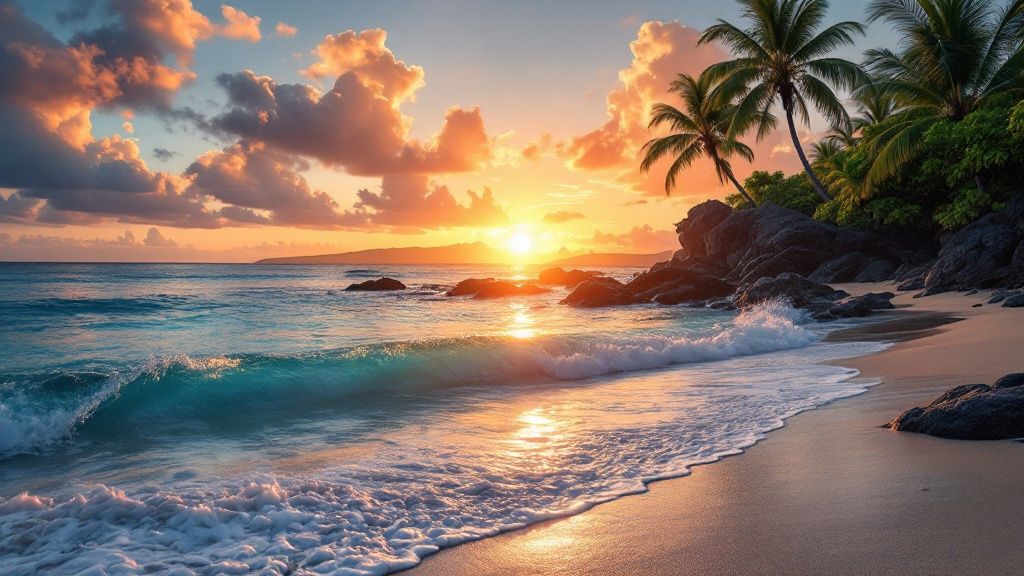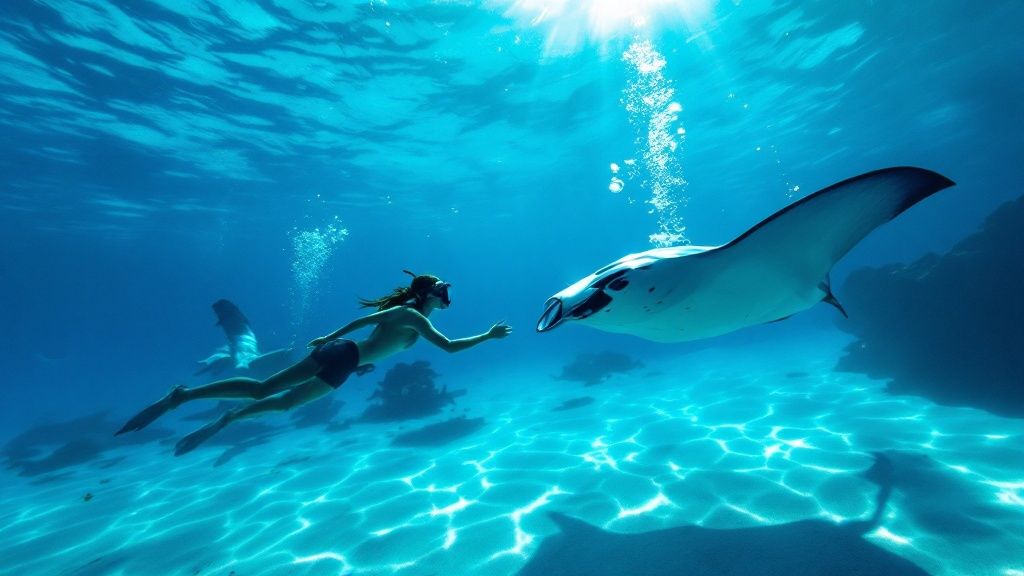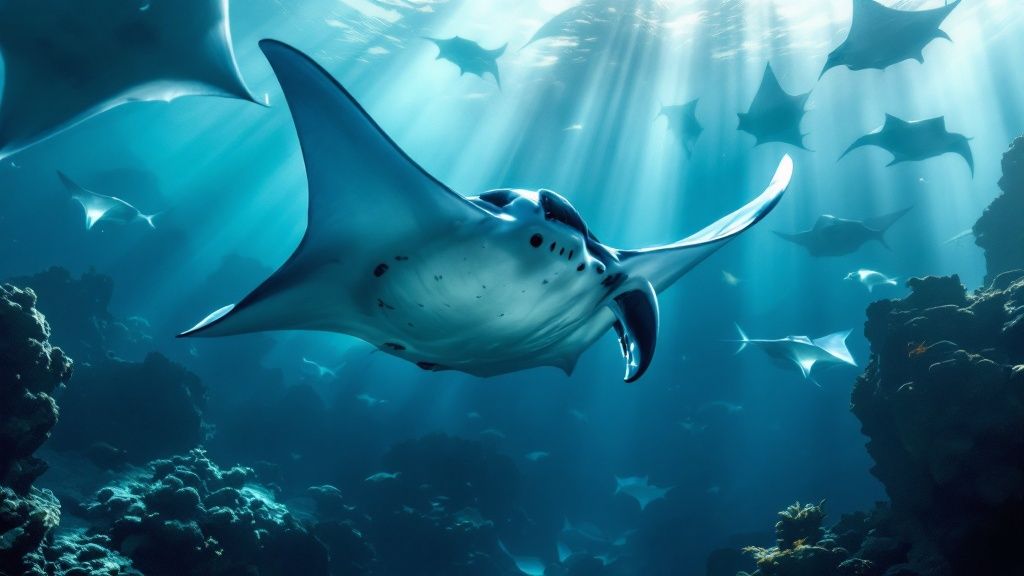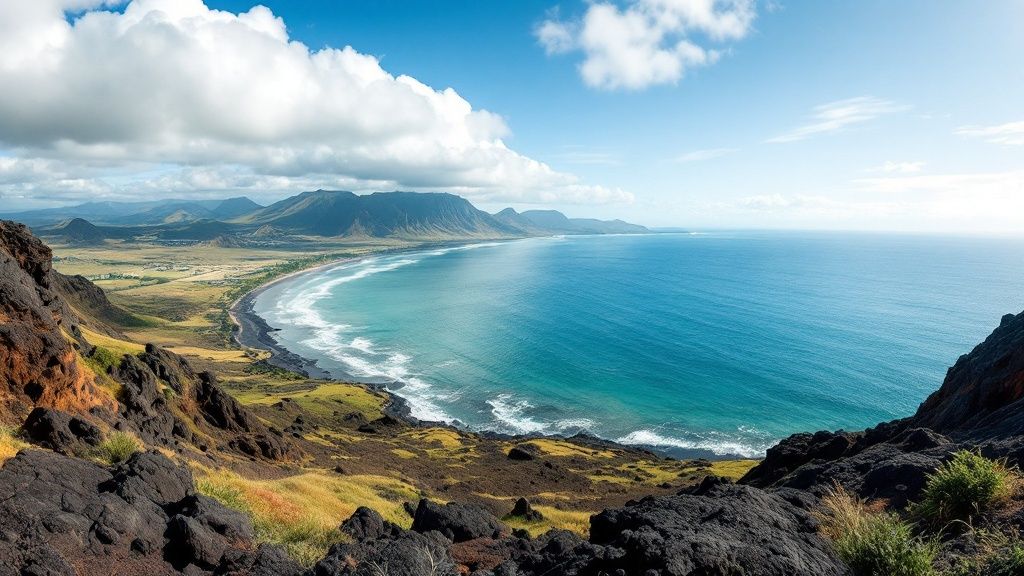Snorkel with Manta Rays Big Island: Dive into Magic
- Byron
- Mar 28
- 12 min read
The Magic of Manta Ray Encounters on Hawaii's Big Island

The Big Island of Hawaii offers a truly captivating experience: the chance to snorkel with manta rays at night. What was once a niche activity has become a must-do adventure, drawing ocean enthusiasts from around the world. This growing popularity stems from the gentle nature of manta rays, the unique Kona Coast ecosystem, and recent changes in marine tourism regulations.
Why Kona is a Manta Ray Paradise
The Kona Coast provides a perfect sanctuary for these graceful giants. Sheltered bays offer calm, nutrient-rich waters, ideal for plankton, the manta ray's main food source. These bays also offer protection from predators and strong currents, creating a haven for feeding and nurseries. The abundance of microscopic life draws the manta rays to the surface, creating a spectacular sight for snorkelers.
The Allure of Night Snorkeling
Night snorkeling adds an element of mystery to the encounter. As darkness descends, specialized lights attract plankton, creating a mesmerizing "manta ray ballet." The rays glide through the illuminated water, offering a unique spectacle not found anywhere else. The darkness also amplifies the bioluminescence of the plankton, creating a truly magical, sparkling effect.
The growing interest in manta ray night snorkeling is a remarkable phenomenon. The demand for these tours has increased significantly, making them a top attraction on the Big Island. This surge is due to the gentle nature of manta rays, their lack of aggression towards humans, and the 2020 legislation restricting close interactions with dolphins. This prompted travelers to seek alternative, ecologically sound ways to connect with marine life. The warm bays around Kailua-Kona offered the perfect setting. Learn more about this growing trend here. This shift toward responsible tourism has made these encounters even more appealing. You can also explore our sitemap for more related articles.
The Ethical Choice for Wildlife Encounters
Choosing to snorkel with manta rays on the Big Island isn't just unforgettable; it's ethical. By joining these tours, visitors support the local economy and responsible tourism. The emphasis on sustainable interaction minimizes disruption to the manta rays and their habitat. This aligns with the rise of mindful travel, where tourists seek experiences that benefit both themselves and the environment. This conscious decision makes the encounter truly enriching.
Prime Locations to Snorkel With Manta Rays Big Island
The Big Island of Hawai'i offers some incredible snorkeling experiences, but few match the magic of swimming with manta rays. Choosing the right spot can dramatically enhance your encounter, so let's delve into some key locations and what makes them special. This isn't just your typical tourist guide; we'll share insights gathered from local experts and seasoned manta ray enthusiasts.
Manta Village (Garden Eel Cove)
Manta Village, nestled in Garden Eel Cove, is famous for its consistent manta ray sightings. The cove's shallow, sandy bottom creates a perfect breeding ground for plankton, which attracts these gentle giants. This makes it a reliable choice for an unforgettable experience. The calm waters make it ideal for snorkelers of all skill levels, from beginners to experienced adventurers.
Manta Heaven (Keauhou Bay)
Just south of Kona, you'll find Manta Heaven in Keauhou Bay. It’s another prime location known for its larger manta ray aggregations, sometimes offering truly breathtaking displays. Conditions here, however, can be a bit more challenging than at Manta Village. Slightly deeper waters and occasionally stronger currents might be tricky for less confident snorkelers. Choosing a reputable tour operator with experienced guides is especially important here.
Lesser-Known Gems and Seasonal Variations
Beyond the popular Manta Village and Manta Heaven, the Big Island holds a few secret spots known for more intimate encounters. Local boat captains often know these hidden gems, which can offer a unique perspective on manta ray behavior. Seasonal changes also affect your sighting chances. Summer (June-August) generally boasts calmer waters and excellent visibility.
To understand the likelihood of spotting these magnificent creatures, it's helpful to look at some data. Along the Kona Coast, manta rays are frequent visitors, and records kept from 2009 to 2014 show just how regular these encounters can be. Underwater videographers documented sightings six to seven nights a week at popular spots like Manta Village and Manta Heaven. This data, collected by Manta Ray Advocates Hawaii, provided valuable insights into their migration patterns and even contributed to research published in the Journal of Fish Biology.
To help you choose the perfect snorkeling location, we've compiled a comparison table highlighting the key features of each spot:
Manta Ray Viewing Sites Comparison: A comparison of the main manta ray snorkeling locations on the Big Island, highlighting their unique features and considerations.
Location | Best Time | Average Group Size | Sighting Rate | Water Conditions |
|---|---|---|---|---|
Manta Village | Year-round | Medium | High | Calm |
Manta Heaven | Year-round | Large | High | Variable |
Lesser-Known Gems | Varies by site | Small | Variable | Variable |
As you can see, each location offers its own advantages. Manta Village provides calm and predictable conditions, ideal for families and beginners. Manta Heaven offers the chance to see larger groups, while lesser-known gems provide a more exclusive experience.
Choosing Your Departure Point
The location of your boat departure point matters, too. Some offer shorter rides, minimizing travel time and seasickness, while others boast scenic coastal views during the journey. Consider your priorities– travel time, potential seasickness, and scenic beauty – when selecting your tour. By understanding these elements, you can craft a truly unforgettable manta ray encounter. You can also check out our other blog posts for more information.
Selecting the Perfect Manta Ray Tour Experience
Snorkeling with manta rays on the Big Island is an unforgettable experience. Choosing the right tour can truly elevate your adventure. It's not just about finding the cheapest deal; it's about finding an operator that prioritizes both a memorable experience and responsible wildlife interactions. Let's delve into what makes a manta ray tour truly exceptional.
Guide-to-Guest Ratio and Expertise
A low guide-to-guest ratio is key for a personalized and safe snorkeling experience. Smaller groups mean guides can offer individual attention, answer your questions, and address any concerns you might have while in the water. Look for tours with a maximum of 10-15 guests per guide. Guides with deep knowledge of manta ray behavior and the local ecosystem can enrich your experience significantly, offering valuable insights. This expertise makes for a more informative and meaningful encounter with these gentle giants.
Equipment Quality and Comfort
The right equipment plays a vital role in your comfort and overall enjoyment. Make sure the tour operator provides high-quality wetsuits that fit well and offer enough warmth, especially for night excursions. Well-maintained masks, snorkels, and fins are also essential for a clear view of the manta rays. It's a good idea to ask about the types of flotation devices offered. Some operators provide comfortable pool noodles or flotation belts for those who want extra support.
Questions to Ask and Red Flags to Watch Out For
Don't hesitate to ask potential tour operators specific questions. Inquire about their safety protocols, guide experience, and group sizes. Reputable operators are transparent and happy to address any concerns. Be cautious of operators who guarantee sightings; manta rays are wild animals, and their presence is unpredictable. Overcrowded boats and aggressive marketing tactics can be red flags, suggesting a focus on profit rather than responsible wildlife interaction. A boat packed with snorkelers is more likely to disrupt the mantas' natural behavior.
The safety and operational aspects of these tours have come under scrutiny. As of 2015, at least 42 commercial tour operators were working at two primary locations, with over 290 people in the water on busy nights. This underscores the importance of strong safety protocols and regulations. Learn more here.

Booking Strategies and Pricing Expectations
Booking your tour in advance is highly recommended, particularly during peak season. Some operators offer online booking discounts or early reservation deals. Consider booking your manta ray snorkel early in your trip. Many companies have a "manta guarantee," letting you re-book for free if no mantas are sighted on your first tour. Prices vary depending on group size, tour duration, and included amenities. Budget-friendly options typically start around $100-$150 per person, while premium experiences can range from $150-$250 or more. Check out our sitemaps for additional information.
Careful research and planning are essential for an extraordinary and ethical manta ray experience. Choosing the right tour contributes to the long-term protection of these magnificent creatures and their habitat.
Your Manta Ray Journey: From Boat to Ocean Magic

A manta ray night snorkel is more than just another item to check off your bucket list; it's an experience filled with anticipation and awe. This journey begins the moment you step onto the boat and culminates in a magical encounter with these gentle giants. Let's explore what awaits, turning any pre-trip jitters into pure excitement.
Setting Sail: The Anticipation Builds
As you board the boat, often near sunset, the air is thick with the salty scent of the ocean and the buzz of excited chatter. The coastline slowly fades into the distance, creating a picturesque scene against the darkening sky. The crew, often knowledgeable about the local marine life, share insights about manta rays and what to expect, further heightening the anticipation.
Arrival at the Snorkeling Site: Preparing for Magic
Arriving at the snorkeling site, typically Keauhou Bay or Garden Eel Cove, the crew provides a thorough safety briefing and instructions. You'll be fitted with a wetsuit, snorkel gear, and a flotation device, often a simple pool noodle. The crew then lowers lights into the water, attracting the plankton that make up the manta rays' diet. This sets the stage for the mesmerizing underwater ballet about to unfold.
The Manta Ray Ballet: A Breathtaking Spectacle
As your eyes adjust to the darkness, shadowy forms begin to materialize from the depths. The manta rays, drawn by the illuminated plankton, glide gracefully through the water. Their enormous wingspans create an ethereal dance, highlighted by the otherworldly glow of the underwater lights.
The lights reveal the manta rays' unique markings and their graceful movements. You'll witness fascinating feeding behaviors as they perform barrel rolls and backflips, efficiently filtering plankton from the water. These movements, often appearing playful, are essential to their survival. It's a truly immersive experience, connecting you to these magnificent creatures and the magic of the ocean.
Manta Ray Sightings and Practical Considerations
While these encounters are usually breathtaking, it's important to remember that manta rays are wild animals. Companies like Jack's Diving Locker report an 85-90% success rate for manta ray sightings on their night snorkeling trips. However, there's no guarantee. To address this, some operators offer a manta guarantee, allowing participants to join another trip if mantas aren't sighted.
This policy helps manage expectations while encouraging responsible and flexible travel planning. Weather, sea conditions, and mooring availability at Garden Eel Cove and Keauhou Bay can impact visibility and the overall experience. More detailed statistics on sightings and conditions are available on their Manta Report. It's also wise to consider the possibility of seasickness, especially at night, and take precautions if needed.
Addressing Concerns About Night Snorkeling
Many first-timers are apprehensive about snorkeling in the dark. However, the reality is far less daunting than imagined. Experienced guides, flotation devices, and the emphasis on staying with the group create a safe and comfortable environment. The wonder of the manta rays quickly replaces any initial anxiety, transforming the experience into an unforgettable adventure.
Conservation Stories Behind the Manta Ray Experience
Snorkeling with manta rays on the Big Island is more than just a typical tourist attraction. It's a unique blend of conservation, culture, and responsible tourism. Understanding the biology and ecological importance of these creatures enhances the experience, revealing their surprising intelligence, their vital role in the ocean, and the ongoing efforts to protect them.
Unveiling the Mysteries of Manta Rays
Manta rays, encompassing both the reef manta ray (Mobula alfredi) and the giant oceanic manta ray (Mobula birostris), possess remarkable qualities. Their intelligence is truly captivating, displaying complex behaviors and even recognizing individual people. With a lifespan of up to 50 years, the need for long-term conservation strategies becomes clear.
Researchers use the unique markings on their undersides, similar to fingerprints, to track individual mantas. This method allows them to study their movements, social interactions, and monitor population health, providing valuable insights into the impact of environmental changes.
The Role of Responsible Tourism
The popularity of manta ray snorkeling directly benefits their conservation. The thriving tourism industry around these gentle giants funds research and protection efforts. An estimated 80,000 people snorkel or dive with manta rays annually on the Big Island, making it a significant economic driver.
Operators, like the Outrigger Kona Resort & Spa, offer nightly tours, further highlighting the demand for this experience. Hawaiian waters are home to two species of manta rays: the reef manta ray and the giant manta ray. Learn more about these incredible creatures here. While not currently endangered, manta rays are classified as threatened under international conventions due to the dangers of commercial fishing.
Cultural Significance and Conservation
Manta rays hold profound spiritual meaning in Hawaiian culture, often appearing in traditional stories and chants like the kumulipo, the Hawaiian creation chant. This reverence fosters a deep connection between the local community and the protection of these animals.
The cultural respect for manta rays aligns with modern conservation approaches, encouraging sustainable tourism that benefits both the environment and the local economy. This combination of traditional wisdom and scientific understanding guides the ethical framework for manta ray tourism on the Big Island. For more information, explore our blog categories.
Threats and Protection Efforts
While responsible tourism is crucial for conservation, manta rays still face serious threats. Bycatch, the accidental entanglement in fishing nets, is a major concern. Habitat degradation and the impacts of climate change also pose challenges to their survival.
However, the revenue generated from sustainable tourism directly supports research into these threats and fuels initiatives to mitigate them. These efforts include advocating for stronger fishing regulations and promoting marine protected areas.
Swimming with manta rays at night as they feed on plankton attracted by lights is a humbling and inspiring experience. It highlights the power of responsible tourism and the importance of understanding the fragile balance between human interaction and wildlife conservation. This awareness ensures that future generations can also experience the magic of these graceful creatures.
Expert Tips for an Unforgettable Manta Ray Encounter

Want to turn your manta ray snorkel trip from memorable to truly magical? It's all in the details. This insider guide, packed with advice from seasoned guides and manta ray enthusiasts, will help you make the most of your Big Island experience. We'll cover everything from pre-trip planning to capturing those amazing underwater photos.
Pre-Snorkel Preparations for a Smooth Experience
A little preparation goes a long way. Addressing potential seasickness before you even step on the boat is key, especially for night excursions. Some over-the-counter remedies can be very effective. A quick practice session with your snorkel gear earlier in the day can also build confidence, especially if you're new to snorkeling or a bit nervous about night swims.
Understanding the tour logistics can also help calm any pre-trip jitters. Knowing the meeting point, boat ride duration, and what to expect in terms of boat size, group numbers, and lighting will help you feel more prepared and relaxed.
Mastering In-Water Techniques
Once you're in the water, a few simple techniques can dramatically enhance your manta ray encounter. Staying calm and minimizing your movements allows for closer, more natural interactions with these graceful creatures. Position yourself near the light source—without blocking it—for the best viewing opportunities, as the plankton attracted by the light will also attract the mantas.
Understanding how manta rays feed helps you anticipate their movements. They perform a graceful "ballet" as they filter plankton, allowing you to position yourself perfectly for observation. Remember, never touch a manta ray. Touching them disrupts their protective mucus layer and can be harmful.
Essential Gear and Gadgets
The right gear can significantly improve your comfort and enjoyment. While wetsuits are often provided, bringing a light sweater for the boat ride back is a great idea, particularly after being in the cool night water. A quick-drying towel and a change of clothes are also practical additions.
Bringing your own well-fitting snorkel gear can enhance comfort and allow for a more personalized experience. For capturing those unforgettable moments, GoPro or other waterproof cameras are excellent choices. Securely attach them to floats or wrist straps to prevent loss and enjoy hands-free manta ray viewing. Remember: no flash photography, as it can disturb the manta rays and other marine life. Want to improve your underwater photography? Check out this article: How to master underwater photography with a GoPro.
Respectful Interaction Practices
Respectful interaction is essential for both you and the manta rays. These vulnerable creatures face threats like bycatch and habitat degradation. Maintaining a respectful distance, following your guide’s instructions, and refraining from touching the mantas ensures a sustainable and enriching experience for everyone.
From Great to Unforgettable: Post-Snorkel Tips
The experience doesn’t end when you’re back on the boat. Sharing your photos and stories keeps the magic alive. Taking time to reflect on your encounter deepens your appreciation for these gentle giants and their delicate ecosystem. These small details are what transform a great experience into an unforgettable memory.
Essential Packing List for Manta Ray Snorkeling
The following table outlines key items to bring for a smooth and enjoyable manta ray snorkeling experience.
Item | Purpose | Recommended/Optional | Notes |
|---|---|---|---|
Swimsuit | For snorkeling | Recommended | |
Towel | Drying off after snorkeling | Recommended | Quick-drying is ideal |
Change of Clothes | Staying comfortable after the snorkel | Recommended | |
Light Sweater/Jacket | Staying warm on the boat | Recommended | Especially for night tours |
Seasickness Medication | Prevent motion sickness | Optional | Especially for those prone to seasickness |
Snorkel Gear | Clear underwater view | Optional | Can bring your own for comfort |
Waterproof Camera | Capturing photos/videos | Optional | GoPro or similar, with float/wrist strap. No flash photography. |
Reef-Safe Sunscreen | Protecting yourself and the marine life | Recommended | Apply before the tour |
Having these items will ensure you're comfortable and prepared for your adventure.
Ready for an unforgettable adventure? Book your Manta Ray Night Snorkel Kona Hawaii Tours today and experience the magic firsthand!
Comments